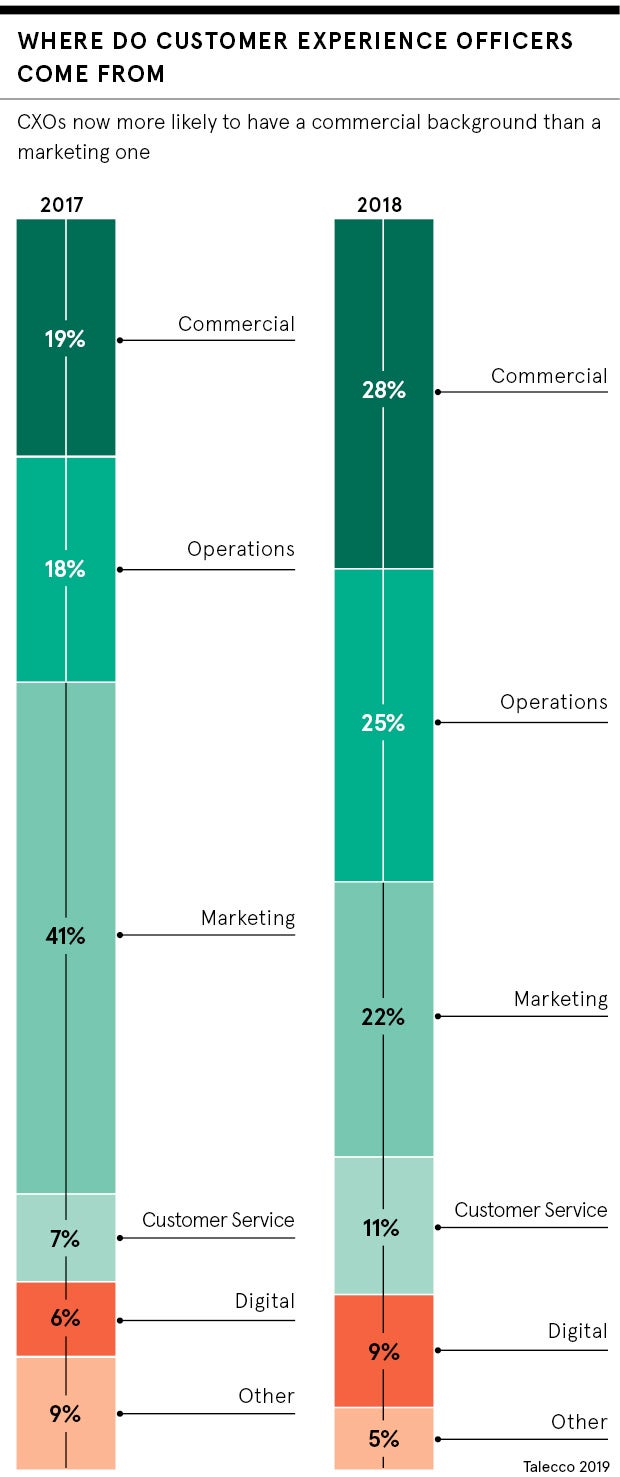When Mastercard poached Donald Chesnut from SapientRazorfish to fill its first chief experience officer (CXO) role, a significant shift was occurring in the business world.
“Providing customers with a clear, consistent and rewarding experience is what differentiates leaders from the rest of the pack,” Mastercard’s chief product officer Michael Miebach, explained.
Mastercard isn’t the only business introducing the CXO role into its corporate hierarchy. Carmaker Ford named Elena Ford chief customer experience officer in 2018. Elsewhere, hotel chain Marriott has just elevated long-time executive Peggy Fang Roe to global officer for customer experience, loyalty and new ventures.
As ever, those who influence the interactions brands have with their customers are also getting in on the act. Advertising holding group Engine Group and consulting giant Accenture have both hired experience bosses of late.
Providing customers with a clear, consistent and rewarding experience is what differentiates leaders from the rest of the pack
The companies filling such positions expect the CXO to act as a connector between multiple disciplines across their organisations.
Matt Holt, who leads the strategy unit at advertising agency Digitas, working with clients like Kellogg’s and Honda, says CXOs have a key part to play as educators and internal enablers across marketing, operations, technology and other parts of the business that contribute to the customer experience.
“In the short term, the role of the CXO is to educate stakeholders and achieve organisation-wide consensus across diverse interests, for example convincing the chief financial officer that investing in experience delivers strong return on investment,” he says.
So why is it only now that the CXO role is becoming an increasingly important voice in the boardroom? And can a business really call itself “connected” without one?
Companies must ‘obsess’ over customer experience
A positive, fulfilling and even enjoyable customer experience has never been more important for companies as they look to drive profit and stay ahead of the competition.
The explosion of digital means brands are now overwhelmed by channels through which they can reach customers, be it Amazon, social media or in-store. In correlation, customer expectations have moved well beyond the provision of good service and aftercare.
Agile, technology-focused businesses are ahead of the curve with this trend. Airbnb, for instance, has been focused on building end-to-end travel experiences for tourists using its app. Last year, Mastercard launched its first flagship Priceless restaurant in New York along with a Bistro at Rome International Airport, all part of a strategy it says is designed to “cut through the clutter” and link the brand to joyous sensory experiences.
However, though many enterprises are pivoting to a more customer-centric way of working, there is still a significant gap between the experiences customers now expect and those being delivered.
A 2018 global survey from digital experience firm Acquia found that while 87 per cent of brand marketers believe themselves to be adequately delivering customer experiences, less than half of customers agree.
The ramifications for businesses that fail to address this disconnect are huge and material. A US survey from Oracle notes that 43 per cent of consumers will blacklist a brand as a result of a bad experience. A further 34 per cent say they will never shop with a company again after just one poor interaction.

Inability to focus on customer satisfaction also has reputational consequences. According to Esteban Kolsky, head of CX strategy at SAP, 72 per cent of customers will share a positive experience with six or more people. On the other hand, if a customer is left unhappy with the service they receive, 13 per cent will go on to share their experience with 15 or even more.
“In a commercial landscape where an increasing number of companies are purposefully engaging directly with their customer base, as opposed to going through retail outlets, the successful ones obsess about good customer experience,” says David Indo, chief executive at management consultancy ID Comms.
“Get it wrong and your customer base will fall off a cliff, get it right and you’ve unlocked true competitive advantage.”
One way for businesses to close this experience gap is to add a dedicated CXO role to their board.
A more holistic approach to CX strategy
Gartner’s recent customer experience management survey indicates that an increasing number of companies are hiring for the role. In 2017, more than 35 per cent of US organisations lacked a CXO, chief customer officer or equivalent. However, in 2019 only 11 per cent and 10 per cent lacked one or the other role, respectively.
The significant growth demonstrates the emphasis firms are now placing on both customer centricity and internal connectivity.
However, Holt at Digitas expects that in the long term the CXO role will eventually be banished as enterprises take a more holistic approach to customer interaction.
“The hope is it will no longer be needed as everyone in the company begins to understand the importance of customer experience,” he says.
“There are clear parallels here with preceding debate around the role of the chief digital officer (CDO). The best CDOs made their role redundant because stakeholders now all understand the importance of digital. And so it should be with customer experience.”
Christian Polman, chief strategy officer at brand consultancy Ebiquity, agrees that not all companies need a CXO.
“However, all consumer-facing businesses certainly need to have a vision for the customer experience, along with a clear prioritisation of areas for investment, co-ordination and senior steering, and a steady flow of data and insights that help break down silos and ensure organisational alignment,” he says.
Whatever the future holds for the CXO role, one certainty is that investing in customer experience must become the new normal for brands, if they want to stand out from the rest.
